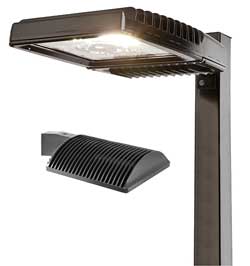LED parking lot lights are finding use on a variety of properties, from businesses to schools, to government buildings to industrial complexes. The reasons why are simple, and are relevant to every kind of property owner. Exterior illumination is a major component of a property’s energy costs, as these fixtures have to cover a lot of area. Because of this, inefficient fixtures will have a multiplicative effect on the property’s energy expenditures. But it’s not just about efficiency, as LEDs can reduce operating costs in other ways as well.
The Gold Standard of Area Illumination

- Diode fixtures are more advanced all the way around. Diode fixtures represent the current pinnacle of illumination technology, and this can most clearly be seen in how efficient the technology is. In most cases, diode fixtures are used to replace metal halides or pressurized sodium lamps, and both of these fixtures are notorious for the amount of loss they produce during normal operation. Both have to be fitted with bulky reflectors, as they emit light in all directions, and this, along with the natural loss of a metal filament or gas chamber, means more power is needed to get adequate illumination. LED fixtures do not suffer from these issues.
- Diode fixtures are extremely long lived. Metal halides last, at best, 10,000 or so hours before requiring replacement, and this is rarely achieved. Metal halides and sodium fixtures drop their lumens as they age, so they may need to be replaced even sooner. LED parking lot lights last up to 100,000 hours and they will not drop lumens as they reach end of life. This can save a property thousands in maintenance costs annually, and the fixtures may be completely maintenance free for years after installation.
- Diode fixtures can be tied to many forms of control. Diode fixtures are manufactured with modern circuitry, and this circuitry responds well to various control features. Occupancy controls are a popular addition, as they can dim the fixtures when no one is nearby, driving down energy expenditures further. There are some impressive control options that will soon become standard, as well, including fixtures that report faults before the fixture fails outright.
- Diode fixtures offer a much better spread of illumination. Efficiency and controllability are important, but they don’t mean much if the fixtures don’t create adequate illumination. Fortunately, LED parking lot lights excel in this area as well, because they are easier to control and aim than other forms of illumination. The result is an even spread of illumination that renders color better than metal halides or pressurized sodium options.
There is little holding LED parking lot lights back from taking over the industry, and it won’t be long before they do exactly that. With superior cost effectiveness, it’s hard to imagine why property owners would consider anything else.






